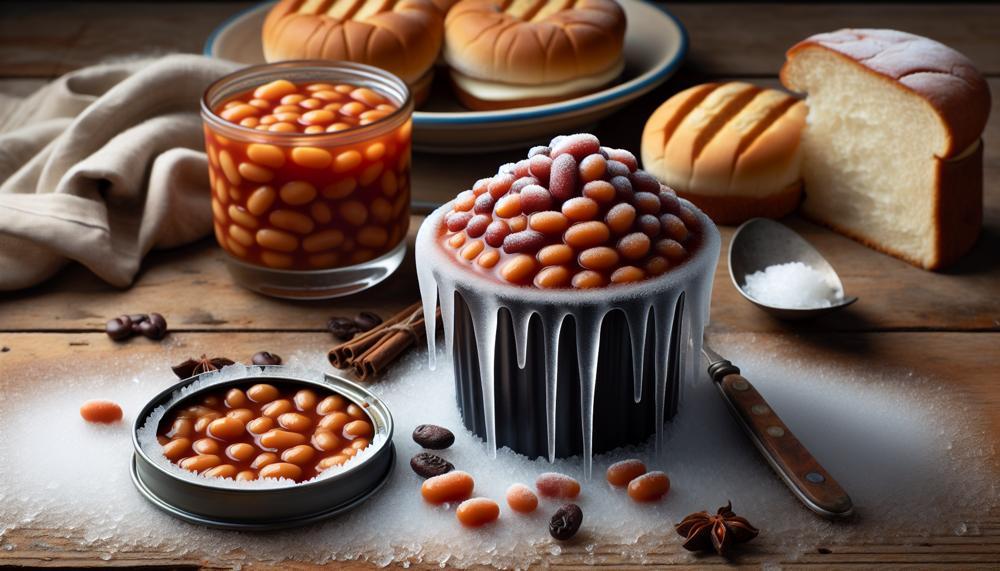Did you know that you can freeze baked beans? Whether you have a delicious homemade batch or a can of your favorite brand, freezing baked beans is an excellent way to prevent food waste and ensure that you can enjoy them at a later time. By freezing baked beans, you can extend their shelf life without compromising their flavor or texture.
So, can you freeze baked beans?
Yes, you can freeze baked beans to maintain their flavor and freshness. Freezing can be a good option if you don’t plan to eat your baked beans right away, or if you made them ahead of time. Cooked beans can keep in the freezer for 2 to 3 months, but their flavor and texture may begin to deteriorate after that time.
Contents
Key Takeaways:
- Freezing baked beans is a sustainable way to reduce food waste and save time.
- Thawed baked beans can be reheated on the stovetop, in the microwave, or in the oven.
- Baked beans can be frozen for up to six months without losing their taste.
- Proper storage containers and techniques are essential for freezing baked beans.
- Cooling baked beans completely before freezing helps maintain their texture.
Why Freeze Baked Beans?
Freezing baked beans offers several benefits, including reducing food waste, providing convenient storage, and helping to maintain their delicious flavor and texture. By freezing baked beans, you can enjoy a nutritious and tasty meal anytime you want, while also saving time and resources. Let’s explore the advantages of freezing baked beans in more detail.
Benefits of Freezing Baked Beans
- Reduces food waste: Freezing baked beans is an excellent way to prevent leftovers from going to waste. Whether you have homemade baked beans or canned ones, freezing them allows you to extend their shelf life and enjoy them at a later time.
- Convenient storage: By freezing baked beans, you create a convenient storage option for preserving their quality. You can easily portion them into individual servings and have them ready to heat up whenever you need a quick and satisfying meal.
- Saves time: Freezing baked beans eliminates the need to cook them from scratch every time you want to enjoy them. With frozen baked beans on hand, you can simply thaw and reheat them, saving precious time in the kitchen.
- Reduces carbon footprint: Opting for frozen baked beans instead of meat-based proteins can help reduce your carbon footprint. The production of plant-based foods generally requires less energy and water compared to animal protein, making frozen baked beans a more environmentally friendly choice.
“Freezing baked beans is a sustainable way to cut down on food waste and save time.”
Comparison of Environmental Impact: Frozen Baked Beans vs. Meat-based Proteins
| Frozen Baked Beans | Meat-based Proteins | |
|---|---|---|
| Energy consumption | Lower | Higher |
| Water usage | Lower | Higher |
| Carbon emissions | Reduced | Higher |
By choosing frozen baked beans as a staple in your freezer, you can make a positive impact on both your food waste and the environment.
How to Freeze Baked Beans
When it comes to preserving the delicious taste and texture of baked beans, freezing is a simple and effective method. Whether you have homemade baked beans or canned ones, proper storage is key to maintain their quality. Here are the steps to freeze baked beans:
Freezing Homemade Baked Beans
- Cool: Allow the homemade baked beans to cool completely before freezing. This prevents moisture buildup and helps maintain their texture.
- Package: Transfer the cooled baked beans into a sealable plastic bag or a freezer-safe container.
- Leave Room for Expansion: To avoid any containers bursting during freezing, make sure to leave some room for expansion.
- Label and Date: Lastly, label the container with the date of freezing. This ensures that you can keep track of the storage time.
Freezing Canned Baked Beans
- Transfer: If you have canned baked beans, transfer them into a freezer-safe container before freezing.
- Leave Room for Expansion: Just like with homemade baked beans, make sure to leave some room for expansion in the container.
- Label and Date: To maintain organization, label the container with the date of freezing.
By following these simple steps, you can freeze both homemade and canned baked beans without compromising their taste or texture. With proper storage, you’ll be able to enjoy your favorite baked beans at a later time without any loss in quality.
How to Thaw Baked Beans
Thawing frozen baked beans is essential before reheating them to ensure even heating and maintain their delicious taste. I will share three different methods to thaw your frozen baked beans: refrigerator thawing, stovetop thawing, and microwave thawing.
Refrigerator Thawing
Refrigerator thawing is the recommended method for thawing baked beans as it promotes slow and even thawing, preventing bacteria growth. Follow these steps:
- Remove the frozen baked beans from the freezer the night before you plan to use them.
- Place the container of frozen baked beans in the refrigerator.
- Allow the baked beans to thaw in the refrigerator overnight.
This method requires some planning ahead, but it is the safest and most convenient way to thaw your baked beans.
Stovetop Thawing
If you need to thaw your baked beans more quickly, you can use the stovetop thawing method. Here’s how:
- Place the frozen baked beans in a saucepan.
- Heat the saucepan over low heat.
- Gradually add a small amount of water to the saucepan to assist in the thawing process.
- Stir occasionally to ensure even heating and prevent the beans from sticking to the bottom.
Stovetop thawing is a faster alternative to refrigerator thawing, but it requires more attention and constant stirring to prevent the beans from scorching or overcooking.
Microwave Thawing
If you’re short on time and need to thaw your baked beans quickly, you can use the microwave. However, this method may affect the texture of the beans and is not recommended for large quantities. Here’s how to do it:
- Transfer the frozen baked beans to a microwave-safe dish.
- Set the microwave to the defrost or low-power setting.
- Heat the baked beans in short bursts, stopping to stir between each burst.
- Continue until the beans are fully thawed.
Note that microwave thawing may result in slightly softer beans compared to the other methods.
In conclusion, thawing frozen baked beans is crucial before reheating them. The refrigerator thawing method is the safest and most recommended, followed by stovetop thawing for faster results. Microwaving is an option but may affect the texture of the beans. Choose the method that best suits your time constraints and preferences.
How Long Can You Freeze Baked Beans?

Baked beans can be frozen for up to six months without compromising their flavor. During this time, they will maintain their taste and texture, allowing you to enjoy them at your convenience. However, it’s important to note that after the three-month mark, frozen baked beans may start to lose some of their taste. To ensure the best quality, it is recommended to use them within this timeframe and avoid storing them for longer periods.
The Shelf Life of Frozen Baked Beans
The shelf life of frozen baked beans depends on various factors, including the storage conditions and the quality of the beans before freezing. When properly stored in airtight containers or freezer-safe bags, baked beans can maintain their taste and texture for up to six months. Freezing helps preserve the flavors and prevents spoilage, making it a convenient storage option for those who want to enjoy their favorite beans for an extended period.
Recommended Storage Time
For the best quality and taste, it is recommended to use frozen baked beans within six months of freezing. While they may still be safe to eat after this time, the flavor and texture may not be as optimal. To avoid any potential loss in quality, it’s important to consume them within the recommended storage timeframe.
| Storage Time | Quality of Frozen Baked Beans |
|---|---|
| Within 3 months | Best quality, optimal flavor and texture |
| 3-6 months | Good quality, slight loss in flavor and texture |
| After 6 months | Potential loss in quality, flavor and texture may be compromised |
It’s important to note that the recommended storage time may vary based on the individual preferences and tolerance for any potential changes in flavor and texture. Some individuals may find the taste satisfactory even after the six-month mark, while others may prefer to use the beans within a shorter period for the best culinary experience.
Tips for Freezing Beans Correctly
When it comes to freezing beans, proper preparation is key to preserving their texture and preventing freezer burn. Follow these tips to ensure your frozen beans stay fresh and flavorful:
- Avoid overcooking or overheating the beans before freezing. This can result in a loss of texture and quality.
- Add acidic ingredients like vinegar or lemon juice at the end of the cooking process. The acidity helps preserve the freshness of the beans during freezing.
- Cool the cooked beans completely before freezing them. Allowing them to come to room temperature helps prevent texture loss.
- Choose the right container for freezing. Use airtight plastic containers or resealable plastic bags to minimize exposure to air, which can lead to freezer burn.
- Leave some space in the container for expansion during freezing. This will prevent containers from bursting and allow the beans to freeze evenly.
By following these freezing tips, you can ensure that your beans retain their texture and flavor when thawed, providing you with delicious beans for your meals.
Expert Tip:
“For the best freezing results, blanch the beans before freezing. This involves briefly boiling them and then immersing them in ice water to stop the cooking process. Blanching helps maintain their color, texture, and nutritional value.” – Chef Sarah Thompson
| Tips for Freezing Beans | Benefits |
|---|---|
| Avoid overcooking or overheating beans. | Preserves texture and quality of the beans. |
| Add acidic ingredients at the end of cooking. | Preserves freshness during freezing. |
| Cool the beans completely before freezing. | Prevents texture loss. |
| Choose the right container for freezing. | Minimizes exposure to air and freezer burn. |
| Leave space in the container for expansion. | Prevents bursting and promotes even freezing. |
The Best Containers for Freezing Beans
When it comes to freezing beans, choosing the right storage containers is key to maintaining their quality and flavor. Freezer-safe containers that have a tight seal are essential in preventing air from entering and affecting the beans. Here are some options:
Glass Containers and Jars
Glass containers and jars are excellent choices for freezing beans. They are durable, non-reactive, and easy to clean. Look for containers with airtight lids to ensure a proper seal. The transparency of glass also allows you to easily identify the contents inside.
Plastic Bags
Plastic bags are a convenient option for freezing beans, especially if you want to save space in your freezer. Choose thick, durable, and freezer-safe bags that can withstand low temperatures. It’s important to remove as much air as possible from the bag before sealing it to prevent freezer burn.
Plastic Containers
Plastic containers with tight lids are another suitable choice for freezing beans. Ensure that the containers are labeled as freezer-safe to avoid any risk of breakage or plastic leaching. Additionally, select containers that are the right size for your portion needs, as leaving too much empty space can lead to freezer burn.
Remember to allow the beans to cool completely before transferring them to the containers, as hot or warm beans can create condensation inside the containers, affecting the quality of the frozen beans. Label each container with the date of freezing for easy tracking.
Now that you know the best containers for freezing beans, you can confidently store your beans in freezer-safe options that will preserve their taste and texture. Happy freezing!
How to Reheat Frozen Baked Beans
When it comes to reheating frozen baked beans, you have a few options available. Whether you prefer stovetop reheating, microwave reheating, or oven reheating, each method has its advantages and considerations. The key is to ensure that your reheated baked beans retain their delicious flavor and texture.
Stovetop Reheating:
To reheat frozen baked beans on the stovetop, begin by thawing them in the refrigerator overnight. Once thawed, transfer the baked beans to a saucepan and heat them over low heat. Stir occasionally to prevent them from sticking or splitting. This stovetop method allows you to have control over the heat and ensures even reheating. If the baked beans appear dry while reheating, you can add a splash of water or vegetable broth to keep them moist.
Microwave Reheating:
If you’re looking for a quick and convenient way to reheat frozen baked beans, the microwave is a handy option. However, be cautious when using this method, as reheating in the microwave can sometimes affect the texture of the beans. Start by thawing the baked beans in the refrigerator. Then, transfer them to a microwave-safe dish and cover loosely to prevent splattering. Reheat in short bursts, stirring in between to distribute the heat evenly. Be mindful not to overcook them, as this can lead to a mushy texture.
Oven Reheating:
If you want to achieve a more oven-baked flavor and texture, reheating frozen baked beans in the oven is a great choice. Begin by preheating your oven to 350°F (175°C). Thaw the baked beans in the refrigerator beforehand. Then, transfer them to an oven-safe dish and cover with foil to prevent drying out. Bake for approximately 20-30 minutes or until the baked beans are heated through. This method allows for even heating and helps the flavors meld together.
Regardless of the reheating method you choose, it’s important to reheat the baked beans slowly to prevent flavor loss and maintain their quality. Be sure to keep an eye on them and adjust the heat or cooking time as needed to achieve the desired taste and texture.
How to Store Leftover Baked Beans
If you have leftover baked beans that you don’t want to freeze, it’s important to store them properly to maintain their freshness and prevent spoilage. By following these simple steps, you can ensure that your leftover baked beans remain delicious and safe to eat.
- Transfer to a clean airtight container: Place the leftover baked beans in a clean container that has an airtight seal. This will help to keep out moisture and other contaminants, extending the shelf life of the beans.
- Refrigerate promptly: Place the airtight container with the baked beans in the refrigerator as soon as possible after cooking or serving. Refrigeration slows down the growth of bacteria, helping to prevent spoilage.
- Label and date: It’s a good practice to label the container with the date when the baked beans were originally cooked. This will help you keep track of the storage time and ensure that you use them within the recommended time frame.
- Keep at a consistent temperature: It’s important to store the leftover baked beans in a refrigerator set to a temperature below 40°F (4°C). This will help to maintain the quality and safety of the beans.
- Use within three days: Leftover baked beans should be consumed within three days to ensure their freshness and taste. Discard any leftovers that have been stored for longer than this period.
By following these guidelines, you can store your leftover baked beans safely in the refrigerator and enjoy them for another meal within a few days.
“Proper storage is key to maintaining the taste and quality of leftover baked beans.”
| Storage Method | Recommended Storage Time |
|---|---|
| Refrigerator (at or below 40°F/4°C) | Up to three days |
| Freezer (in airtight containers) | Up to six months |
Conclusion
Freezing baked beans is a convenient and effective way to extend their shelf life and preserve their delicious taste and texture. Whether you have homemade baked beans or canned ones, freezing allows you to reduce food waste and have a quick, nutritious meal at your fingertips whenever you want.
By following the proper freezing and thawing methods, you can enjoy the benefits of freezing baked beans for up to six months. This convenient storage option not only saves you time but also helps reduce your carbon footprint, as it requires less energy and water compared to other protein sources.
So, don’t let your baked beans go to waste! Freeze them in freezer-safe containers, label them with the date, and enjoy the convenience of having a versatile and delicious ingredient ready to use whenever you need it. Whether you’re craving a hearty pasta sauce, a comforting side dish, or a flavorful topping for your favorite dishes, freezing baked beans is the perfect solution for preserving their quality and flavor.
Source Links
- https://www.thewellnourishedmama.com/blog/can-you-freeze-baked-beans
- https://www.bushbeans.com/en_US/bean-hub/article/guide-to-freezing-beans
- https://www.cozymeal.com/magazine/can-you-freeze-baked-beans




